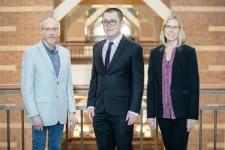Fast-acting, color-changing molecular probe senses when a material is about to fail
2021-03-25
(Press-News.org) CHAMPAIGN, Ill. -- Materials that contain special polymer molecules may someday be able to warn us when they are about to fail, researchers said. Engineers at the University of Illinois Urbana-Champaign have improved their previously developed force-sensitive molecules, called mechanophores, to produce reversible, rapid and vibrant color change when a force is applied.
The new study led by postdoctoral researcher Hai Qian, materials science and engineering professor and head Nancy Sottos, and Beckman Institute of Advanced Science and Technology director Jeffrey Moore is published in the journal Chem.
Moore's team has been working with mechanophores for more than a decade, but past efforts have produced molecules that were slow to react and return to their original state, if at all. This inability to produce an on/off-like response has limited their use as molecular probes that continuously report a material's mechanical condition, the study reports.
"The color change is the result of stress applied to the bonds that connect the mechanophores to a polymer chain," Qian said. "We are now bonding the mechanophores to polymer chains using a different arrangement scheme, called an oxazine structure. The new structure allows for an instantaneous and reversible color change, so instead of the polymer slowly becoming darker over time, the color changes quickly when the force is applied and disappears when the force is removed."
See a videos demonstrating the new oxazine structure and the older spiropyran structure.
Materials that contain the new mechanophores could be used as stress sensors to enable researchers to study the effects of stress on materials before they fail.
"The rapid response and reversibility will allow engineers to better monitor, quickly detect and respond rapidly to an overstressed structure in the lab and eventually in the field," Sottos said.
A long-standing challenge in materials science has been making observations regarding mechanical load and other stresses in materials at the single-molecule level. Although this advancement cannot do this, Moore says the goal is nearer with the development of this new type of mechanophores.
"There is more work to do, but this advancement opens the door to detailed insight of what's going on at the molecular level in all sorts of materials," Moore said. "In the area of biomechanics, for example, we see this research as a steppingstone toward better monitoring of how our bodies react to external forces from the cellular level and beyond."
INFORMATION:
Illinois graduate students Doug Ivanoff and Abigail Halmes and undergraduate student Nathan Purwanto also participated in the study.
The Air Force Office of Scientific Research Center of Excellence supported the research.
Moore also is affiliated with the Center for Advanced Study, the Materials Research Laboratory, the Carl R. Woese Institute for Genomic Biology, the Carle Illinois College of Medicine, chemistry and materials science and engineering. Sottos also is affiliated is CAS, MRL, the Beckman Institute, mechanical engineering and science and aerospace.
Editor's notes:
To reach Jeffrey Moore, call 217-244-5289; jsmoore@illinois.edu.
To reach Nancy Sottos, call 217-333-1041; email n-sottos@illinois.edu.
The paper "Fast, reversible mechanochromism of regioisomeric oxazine mechanophores: Developing in situ responsive force probes for polymeric materials" is available online and from the U. of I. News Bureau. DOI: 10.1016/j.chempr.2021.02.014.
[Attachments] See images for this press release:

ELSE PRESS RELEASES FROM THIS DATE:
2021-03-25
Bright semiconductor nanocrystals known as quantum dots give QLED TV screens their vibrant colors. But attempts to increase the intensity of that light generate heat instead, reducing the dots' light-producing efficiency.
A new study explains why, and the results have broad implications for developing future quantum and photonics technologies where light replaces electrons in computers and fluids in refrigerators, for example.
In a QLED TV screen, dots absorb blue light and turn it into green or red. At the low energies where TV screens operate, this conversion of light from one color to another is virtually 100% efficient. But at the higher excitation energies required for brighter screens and other ...
2021-03-25
In the year since the coronavirus pandemic upended how just about every person on the planet interacts with one another, video conferencing has become the de facto tool for group collaboration within many organizations. The prevalent assumption is that technology that helps to mimic face-to-face interactions via a video camera will be most effective in achieving the same results, yet there's little data to actually back up this presumption. Now, a new study challenges this assumption and suggests that non-visual communication methods that better synchronize and boost audio cues are in fact more effective.
Synchrony Promotes Collective Intelligence
Researchers from Carnegie Mellon's Tepper School of Business and the Department of Communication at the University of California, Santa ...
2021-03-25
Despite having remarkable utility in treating movement disorders such as Parkinson's disease, deep brain stimulation (DBS) has confounded researchers, with a general lack of understanding of why it works at some frequencies and does not at others. Now a University of Houston biomedical engineer is presenting evidence in Nature Communications Biology that electrical stimulation of the brain at higher frequencies (>100Hz) induces resonating waveforms which can successfully recalibrate dysfunctional circuits causing movement symptoms.
"We investigated the modulations in local ?eld potentials induced by electrical stimulation of the subthalamic nucleus (STN) at therapeutic and non-therapeutic frequencies in Parkinson's disease patients ...
2021-03-25
LA JOLLA--The glow of a panther's eyes in the darkness. The zig-zagging of a shark's dorsal fin above the water.
Humans are always scanning the world for threats. We want the chance to react, to move, to call for help, before danger strikes. Our cells do the same thing.
The innate immune system is the body's early alert system. It scans cells constantly for signs that a pathogen or dangerous mutation could cause disease. And what does it like to look for? Misplaced genetic material.
The building blocks of DNA, called nucleic acids, are supposed to be hidden away in the cell nucleus. Diseases can change that. Viruses churn out genetic material in parts of the cell where it's not supposed to be. Cancer cells do too.
"Cancer cells harbor damaged DNA," says ...
2021-03-25
New clues to a long-pursued drug target in cancer may reside within immune cells, researchers at the University of Michigan Rogel Cancer Center have discovered.
The findings, which appear in Nature Immunology, not only shed new light on cancer immunology, they also suggest clinical trials related to this key target -- an interaction that destabilizes the important p53 tumor suppressor protein -- may unnecessarily be excluding a large number of patients.
The researchers are optimistic that the findings could help make immunotherapy treatment more effective against ...
2021-03-25
CORVALLIS, Ore. - Warm river habitats appear to play a larger than expected role supporting the survival of cold-water fish, such as salmon and trout, a new Oregon State University-led study published today found.
The research has important implications for fish conservation strategies. A common goal among scientists and policymakers is to identify and prioritize habitat for cold-water fish that remains suitably cool during the summer, especially as the climate warms.
This implicitly devalues areas that are seasonally warm, even if they are suitable for fish most of the year, said Jonny Armstrong, lead author of the paper and an ecologist at Oregon State. He called this a "potentially severe blind spot for climate change adaptation."
"Coldwater ...
2021-03-25
Lithium-ion batteries have made possible the lightweight electronic devices whose portability we now take for granted, as well as the rapid expansion of electric vehicle production. But researchers around the world are continuing to push limits to achieve ever-greater energy densities -- the amount of energy that can be stored in a given mass of material -- in order to improve the performance of existing devices and potentially enable new applications such as long-range drones and robots.
One promising approach is the use of metal electrodes in place of the conventional graphite, with a higher charging ...
2021-03-25
Many psychiatric disorders have genetic causes, but the exact mechanism of how genes influence higher brain function remains a mystery. A new study provides a map linking the genetic signature of functions across the human brain, a tool that may provide new targets for future treatments.
Led by Bratislav Misic, a researcher at The Neuro (Montreal Neurological Institute-Hospital) of McGill University, a group of scientists performed machine learning analysis of two Open Science datasets: the gene expression atlas from the Allen Human Brain Atlas and the functional ...
2021-03-25
DURHAM, N.C. - Engineers at Duke University have developed an electronics-free, entirely soft robot shaped like a dragonfly that can skim across water and react to environmental conditions such as pH, temperature or the presence of oil. The proof-of-principle demonstration could be the precursor to more advanced, autonomous, long-range environmental sentinels for monitoring a wide range of potential telltale signs of problems.
The soft robot is described online March 25 in the journal Advanced Intelligent Systems.
Soft robots are a growing trend in the industry due to their versatility. Soft parts can handle delicate objects such as biological tissues that metal or ceramic components would damage. Soft bodies can help robots float or squeeze into tight spaces where rigid ...
2021-03-25
Lincoln, Neb., March 25, 2021 -- Palm oil, the most important source of vegetable oil in the world, is derived from the fruit of perennial palm trees, which are farmed year-round in mostly tropical areas. The palm fruit is harvested manually every 10 days to two weeks, then transported to a mill for processing, and ultimately exported and made into a dizzying array of products from food to toiletries to biodiesel.
"You probably ate palm oil for breakfast," said Patricio Grassini, an associate professor of agronomy at the University of Nebraska-Lincoln. "There is probably palm oil in your ...
LAST 30 PRESS RELEASES:
[Press-News.org] Fast-acting, color-changing molecular probe senses when a material is about to fail






